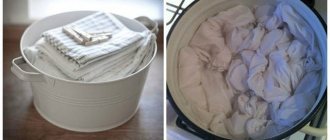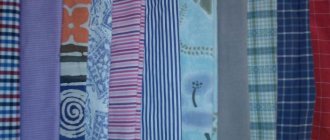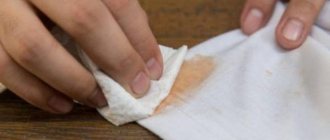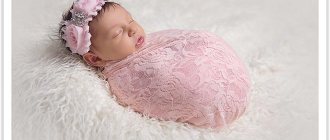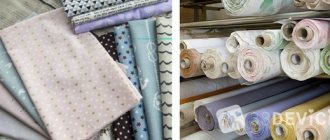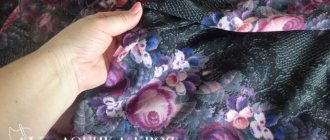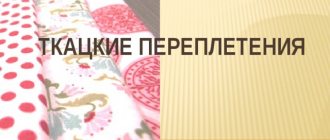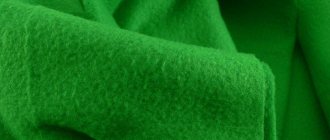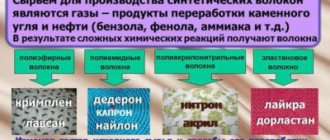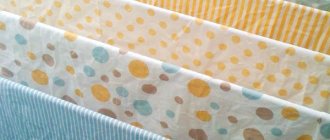What's most important?
When choosing fabric for children, you need to find fault even with the little things, because... The skin of babies, and especially babies, is very delicate and sensitive. She is most susceptible to allergies and damage. This applies to all fabrics that the child comes into contact with, not only bedding and clothing, but also toys and diapers. If we are not textile specialists and cannot clearly determine which fabric is safe, we can use special labeling. Today, textile manufacturers accurately determine the properties of the fabrics they sell. Don't be fooled by the pretty design.
First, let's look at the signs. Fabric with Oeco-Tex certificate indicates that the material is safe for children and is natural and hypoallergenic. This is an international quality mark that will always help you in your choice.
What fabrics and materials are children's clothing made from?
Cotton children's clothing
Cotton is the most popular material in the production of children's clothing. Cotton fabric is natural, hypoallergenic, it absorbs moisture well and, most importantly, it is soft and does not irritate the baby’s delicate skin, so when choosing clothes for a baby, you can find things made from 100% cotton and fabrics based on it.
How to care?
Wash at a temperature of 40-60 degrees, colored clothes - without bleach, be sure to iron things (steam treatment softens seams that can irritate the delicate skin of a child), it is also important to remember that after the first wash, cotton clothes usually “shrink” by 10- 15%.
Children's clothing made from culinary satin stitch
Culinary satin stitch is considered one of the thinnest, lightest, “airy” fabrics based on cotton fiber. Ideal for summer clothes and underwear (vests, T-shirts, panties). Some manufacturers add Lycra to the fiber to make the material more elastic.
How to care?
You can follow the general recommendations for caring for cotton items.
Children's clothing made from footer
Another cotton fiber fabric. Unlike a cooler, footer is a thick, warm fabric; items made from footer may have a fleece on the back side. Footer is used when sewing insulated rompers, bodysuits, hats, panties, and overalls.
How to care?
It is best to wash footer clothes on a delicate cycle or by hand. Thick footer is washed at a temperature of 40-60 degrees, and thin footer - up to 30 degrees. Do not boil; at high temperatures, colored fabric may fade. The footer does not fade in the sun.
Children's clothing made of interlock or dual elastic
From the name you might get the impression that this is a synthetic fabric. But no - interlock is 100% cotton. Interlock is an intermediate option between footer and culinary satin stitch; items made from double elastic are smooth, “silky”, but warm enough (in terms of fabric density, interlock is not inferior to footer). The fabric practically does not stretch or unravel; with proper care, items made from double elastic can last a very long time. It is used to produce thick children's overalls, bib overalls, jumpers, blouses, and pants.
How to care?
Wash at temperatures up to 40 degrees on a delicate cycle or by hand. Without bleaches, wring in a gentle mode, you can iron children's clothes made from interlock, but only from the wrong side at a low temperature. Dry in the fresh air (out of direct sunlight). After the first wash, clothes may shrink a little.
Children's clothing made from terry
Terry fabric is made from cotton or, less commonly, linen, and is somewhat similar to footer, only terry cloth clothing has a thicker and longer pile, due to which it absorbs moisture better. A brushed terry jumpsuit with a thin knitted lining will perfectly protect your baby in cold weather.
How to care?
It is better to use not powders, which penetrate deeply into the fabric and are difficult to wash off (after several washes, the clothes will lose their “velvety” and will be hard), but liquid cleaning products. In any case, it is important to rinse terry items thoroughly (two or three rinsing cycles in a washing machine or additionally by hand). To maintain softness, add conditioner (special for children's clothes). Terry clothes should not be ironed, only gently steamed if necessary. You can dry it in the fresh air, but if things hang out too long, they can again become stiff.
Velsoft children's clothing
Velsoft (microfiber) is made from polyamide (synthetic fiber), but its properties are not inferior to natural fabrics. Velsoft clothing, although it looks like a thick fabric with a pile (in this way it is similar to clothing made from terry cloth), is very light, soft, reliable, and durable. For children, overalls, sweaters, pants, and hats are made from this material for autumn and winter.
How to care?
We recommend gentle washing by hand or in a washing machine at temperatures up to 30 degrees. Microfiber does not fade if you use regular baby powder (when washing any baby clothes, avoid bleaches and chlorine-containing products). There is no need to iron things made of velsoft; if necessary, treat them with steam.
Set of velsoft 1832-23 Set of weightloft 1814-23 Set of terry 1705-16
Children's clothing made of velor
Another type of warm fabric with pile. Velor is made from either cotton or wool. Velor fabric is incredibly strong and durable; velor clothes do not lose their appearance even after several years of use. Often a little synthetic fiber (polyester or viscose) is added to the fabric (not the pile), the fabric becomes more elastic, and things do not stretch out at the knees and elbows. Velor is used to produce both underwear for children (rompers, slips, sweaters) and warm outdoor overalls (as a rule, they come with a soft lining made of 100% cotton).
How to care?
We recommend gentle washing at temperatures up to 30 degrees. Do not soak things; they must be washed immediately (any detergent for children’s clothes is suitable). After washing, you should not wring out clothes; dry them in the fresh air without access to sunlight (velor cannot be dried on a radiator). When washed delicately, velor does not wrinkle or form wrinkles, so ironing is usually not required. As a last resort, at a low temperature, iron things from the inside, or better yet, with the help of steam, which “straightens” the lint well.
Children's fleece clothing
Fleece is a knitted polyester fabric that resembles sheep's wool in appearance. Fleece fabric can be brushed on one or both sides. Children's clothing made from fleece is well ventilated, it is elastic and light, but it is not recommended to put it on a baby's naked body, as it can become electrified. Fleece overalls are great for walking outside in the cool season.
How to care?
Wash at a temperature of 30-40 degrees, do not use bleaches and conditioners (they destroy the water-repellent properties of clothes). Before washing, it is better to turn things inside out and close the zippers (if any). Dry in the fresh air, not on a radiator. Fleece cannot be ironed. Velor envelope 0232-15 Velor envelope Naughty Fleece overalls KBF-5
Children's clothing made from rib or eraser
Ribana (eraser) resembles a “knitted elastic band.” Made from cotton (allows the baby's skin to breathe), often with the addition of lycra (excellent stretch). Baby vests, rompers, and T-shirts are made from 100% cotton ribbed fabric, and hats, blouses, and dresses are made from fabric with the addition of lycra. In general, it can be noted that ribana most closely resembles cooking surface (in density and its properties), but costs a little more.
How to care?
Wash in any mode at temperatures up to 30 degrees, do not wring out by hand, dry in the fresh air, but avoid exposure to sunlight. Children's clothing made from ribbed wool can be ironed.
Children's clothing made from cashcorse
Kashkorse is an elastic knitted fabric (made from cotton) with a classic “English” ribbed pattern. Depending on the type of fabric (there are several fabrics under the general name “cashcorse”), cotton is supplemented with various additives (elastane, lycra, polyester, viscose). Children's T-shirts, bodysuits, turtlenecks, and hats are made from this fabric.
How to care?
Wash at a temperature of no more than 40 degrees. Manual squeezing is not recommended. Iron at low temperature on reverse side
What fabric is most often chosen for children's clothes?
Currently, the most popular fabrics for sewing children's products are natural cotton, Minky fleece, linen and tetra. These fabrics are completely safe for baby's skin. Many parents know that allergic reactions on the child's skin caused by various materials are a fairly common problem. Therefore, fabric manufacturers pay special attention to children's materials and conduct additional tests for the presence of heavy metals and allergenic dyes. Fabrics must be safe, soft and pleasant to the touch.
Types of materials
Woven materials
Soft and shiny, they are most suitable for sewing blouses, shirts, dresses, skirts. Dense woven materials are the most durable, and therefore they are convenient to use for sewing trousers, jackets and jackets.
Best suited for children's clothes
- batiste,
- thin cotton cloth,
- chintz,
- chambray (dress and shirt fabric),
- chino (paper twill),
- denim,
- canvas,
- linen,
- madras (light striped silk fabric and thick striped cotton fabric),
- muslin hard finish,
- polyester taffeta,
- poplin,
- shirting.
Knitted fabrics
Ideal for sewing children's clothes. They are elastic and very comfortable when moving. These include:
- cotton spandex,
- double (stocking) knitwear,
- interlock jersey,
- Jersey,
- double-sided knitwear.
Knitwear
What should you pay attention to when choosing a product for a child?
Safe, certified fabrics are the basis. If we are confident that the proposed material meets these criteria, it is time to select a suitable pattern.
Things for children, clothes, bedding, curtains, carpets, blankets should be filled with color and fabulous designs. The children's world is a different world from the thoughtful world of adults. A child's world should be fabulous and colorful. Bears on the pillow, elephants on the blanket and hearts on the clothes. All this allows the child’s imagination to develop and create new and interesting worlds for his games.
When choosing fabrics for children, you shouldn’t think about how they will fit together or how many years these curtains will last. This is a children's world where everything beautiful will find its admirer and help the child's abilities to develop more.
We must remember that children feel best when surrounded by many flowers, accompanied by many characters from fairy tales and kind, smiling animals. Of course there are limits. In the case of a children's space, bedding colors and their warm shades are better suited. In the combination of warm colors and bright toys, the child feels safe and comfortable.
What material should I choose for my child's dress?
What material should I choose for my child's dress?| Literature, Books, Culture, Art, Philosophy, Cinema | |
| ABOUT ME | ARTICLES | CREATION | BOOKS | CONTACTS |
| Friday, October 12, 2021 |
| Category: Fashion |
| Tags: Dress, child, material |
| Article author: keeplis |
| One of the system-forming criteria for choosing a children's dress is the characteristics of the material from which it was made. It would be superfluous to provide an explanation of why this particular criterion is important, because the fabric used for the dress determines how long the girl will wear it, what it will turn into after the first wash, and to what extent your beauty will feel comfortable in it. Nowadays, children's dresses can be made from a wide variety of fabrics, which allow you to create a variety of textures, prints, and weave finishes. The most common fabrics include cotton, satin, jersey, lavsan, silk, wool, chiffon, lace, satin and much more. Moreover, the vast majority of dresses for girls are created through the use of several materials in combination. Consumers immediately have a question: “Which of the presented fabrics will be safer and more comfortable?” Of course, preference should be given to natural fabrics; more precisely, let’s say, it is from them that the basis of the entire dress should be created. The most widespread nowadays are cotton fabrics, which are characterized by their low cost, high strength and excellent absorption and evaporation of moisture. Dresses made from this fabric are very comfortable, practical, and wash well. An equally popular material, including for sewing dresses, is wool. Most often it is used to create winter clothes, and, if we are talking about children's dresses, it can be combined with cotton or other fabrics. In addition to natural ones, artificial and mixed fabrics can be used to sew dresses. Most often they are used to create individual elements of a dress style; they are airtight and practically do not wrinkle. Blended fabrics that combine natural and artificial fibers, to a certain extent, are an excellent option for sewing a dress for a child, let’s say, for every day. The fact is that such fabric is very pleasant to the touch, safe, ensures proper breathing of the skin, while it does not wrinkle or cause discomfort. It should be noted that if you plan to reuse the purchased dress, you need to pay special attention to the storage conditions of the item. It is best to place the product in the closet on a small hanger. To prevent it from getting dirty, a special cover is put on the dress. After purchasing a product in a store, you must wash it. This is done by hand and dried only on a hanger. The child must be present when purchasing the product; he will help you choose the option that will be most pleasant for the baby. You can allow your child to choose the product on his own - this will improve the development of your relationship with your baby and he will feel like an adult. |
| Subscribe to new articles | |||
| 12-10-2018 | fashion, accessories, winter |
| Fashionable accessories for winter 2016-2017 |
| What accessories will be in fashion in winter? |
| 12-10-2018 | outerwear, winter, women |
| How to choose outerwear for the winter for a woman? |
| How to choose outerwear for a woman in winter? |
| 12-10-2018 | wardrobe, clothing, woman |
| What should be in every woman's wardrobe? |
| What items should be in every woman's wardrobe? |
| 12-10-2018 | Suede, boots, pros, cons |
| Suede boots: pros and cons |
| The article describes the advantages and disadvantages of suede-based boots |
| Culture | ||||||
| Books and Literature | ||||||
| Internet | ||||||
| Finance | ||||||
| Sport | ||||||
| Tourism | ||||||
| Goods | ||||||
| Story | ||||||
| Mystic | ||||||
| Relationship | ||||||
| Family | ||||||
| Repair | ||||||
| Games | ||||||
| Fashion | ||||||
| Medicine | ||||||
| Cooking | ||||||
| State | ||||||
| Auto | ||||||
| Hobbies | ||||||
| Psychology | ||||||
| Design | ||||||
| Miscellaneous | ||||||
| The science | ||||||
| Education | ||||||
| Mon | W | Wed | Thu | Fri | Sat | Sun |
| Running is useful! |
| Headache again?! Creating the “mood” for sex |
| Naughty children. What to do? |
| Reign of Ivan 4 |
The best fabrics for sewing children's clothing
Chintz
- Raw material type:
natural, plant origin
- To the touch:
thin, pleasant, soft
- Purpose:
dress, blouse, linen
| Water resistance | average |
| Hygroscopicity | 6-12% |
| Capillarity | average rate of moisture absorption |
| Breathability | average |
| Vapor permeability | good |
| Electrification | moderate |
| Mercerization of fabrics | processed if necessary |
| Fabric structure | plain (plain or main) weave |
| Method of spinning threads | linen |
| Side | double-face weave |
| Drawing | plain, plain dyed, printed |
| Manufacturers | Belarus, Russia |
| GOST | 29298-2005 |
Pros and cons, care, reviews
Flannel
- Raw material type:
natural, plant or animal origin
- To the touch:
pleasant, soft, dense
- Purpose:
linen, for sewing children's clothing
| Water resistance | low |
| Hygroscopicity | 13-18% |
| Capillarity | high rate of moisture absorption |
| Breathability | average |
| Vapor permeability | good |
| Electrification | moderate |
| Mercerization of fabrics | not processed |
| Fabric structure | plain (plain or main) weave |
| Method of spinning threads | plain or twill |
| Side | one- or two-faced |
| Drawing | plain dyed, plain bleached, printed |
| Manufacturers | Russia |
| GOST | 29298-2005 |
Pros and cons, care, reviews
- What is dress fabric, what types of dress fabrics are there? Their features and characteristics
Poplin
- Raw material type:
natural, plant, less often - animal origin, sometimes with the addition of synthetic
- To the touch:
thin, dense, pleasant, soft
- Purpose:
dress, blouse, linen, curtain
| Water resistance | average |
| Hygroscopicity | 6-12% |
| Capillarity | average rate of moisture absorption |
| Breathability | average |
| Vapor permeability | good |
| Electrification | moderate |
| Mercerization of fabrics | processed if necessary |
| Fabric structure | plain (plain or main) weave |
| Method of spinning threads | linen |
| Side | double-face weave |
| Drawing | plain plain dyed, plain bleached, printed, formed by weaving |
| Manufacturers | Korea, Italy, Belarus, China, Russia |
| GOST | 29298-2005 |
Pros and cons, care, reviews
Interlock
- Raw material type:
natural, plant origin, less often - with the addition of synthetic or artificial
- To the touch:
nice, soft
- Purpose:
dress, blouse, for sewing sportswear and children's clothing
| Water resistance | average |
| Hygroscopicity | 6-12% |
| Capillarity | high rate of moisture absorption |
| Breathability | average, below average |
| Vapor permeability | good |
| Electrification | moderate |
| Mercerization of fabrics | processed if necessary |
| Fabric structure | solid knitted fabric |
| Method of spinning threads | special weave of loops |
| Side | two-faced |
| Drawing | plain, plain dyed, printed |
| Manufacturers | Türkiye |
| GOST | 28554-90 |
| Kinds | singing, ring, openend |
Pros and cons, care, reviews
Kulirka
Other names for fabric: cooler
- Raw material type:
natural, plant origin, sometimes with the addition of artificial or synthetic
- To the touch:
thin, pleasant, soft
- Purpose:
for sewing children's clothing, dresses, blouses
| Water resistance | low |
| Hygroscopicity | 6-12% |
| Capillarity | high rate of moisture absorption |
| Breathability | average |
| Vapor permeability | high |
| Electrification | moderate |
| Mercerization of fabrics | processed if necessary |
| Fabric structure | solid knitted fabric |
| Method of spinning threads | special weave of loops |
| Side | right side front |
| Drawing | plain, plain-dyed, printed, melange |
| Manufacturers | Türkiye |
| GOST | 28554-90 |
| Kinds | singing, card, open end |
Pros and cons, care, reviews
